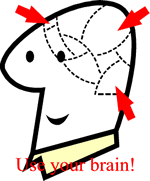The "Oh Duh!" Chord Progression
![]()
I think we have laid the foundation for understanding chord progressions now. We have covered chords from basic triads to extended, altered, suspended, and slash chords. We have learned how the circle of keys works in both major and minor keys. And we have learned how to tell what key a song is in when there are flats in the key signature, when there are sharps in the key signature, and when there is neither.
So let's begin learning some of the most used chord progressions -- the progressions that happen over and over and over again in song after song after song.
The first progression we will consider I have labeled the "Oh Duh!" chord progression. When my daughter, Kendra, was in junior high school, she and her friends used to use that term a lot. Whenever I said something overly obvious, she would say "Oh Duh!" -- meaning, of course, that whatever I said was so painfully obvious that it really didn't need to be said at all.
And that's exactly what this chord progression is -- so obvious that it hardly needs to be mentioned.
Except it DOES need to be mentioned, because most people don't know the fundamentals that YOU now know -- they don't know that there are 3 chords in any key that are MUCH more likely to be used than any others. We call them primary chords -- the I, IV, and V chords.
Just to briefly review, here they are again -- the 3 most used chords -- the primary chords -- in each major key:

You may find it easier to see this information in a tabluar format (note all chords are major chords):
| Key (I) | C | G | D | A | E | B | F#/Gb | C#/Db | Ab | Eb | Bb | F |
|---|---|---|---|---|---|---|---|---|---|---|---|---|
| IV | F | C | G | D | A | E | B | F#/Gb | Db | Ab | Eb | Bb |
| V | G | D | A | E | B | F# | C#/Db | G#/Ab | Eb | Bb | F | C |
So if a song you want to play is in the key of C, what are the chords you would expect to find most?
Right -- C, F, and G.
We also know that the "I" chord is THE most used chord in that key, and songs nearly always (probably 90% of the time) start and end on the I chord.
So if you determine that a song is in the key of F, what is far and away the most likely chord?
Of course. F.
What chord would you expect the song to start on?
Of course. F.
What chord would you expect the song to end on?
Again, F.
So after the first chord, there are just two possibilities for the 2nd chord. Either the IV chord or the V chord. (It might be any chord if you care to get picky, but we're speaking here in mathematical terms. The likelihood of the second chord of a song being anything other than IV or V is small, so if you were betting, you would certainly bet on IV or V.)
So the obvious question then is:
How can I tell whether the second chord is the IV chord or the V chord?
And the answer is:
What's the melody note at that point? Is it part of the IV chord, or part of the V chord?
If the melody note is a member of the IV chord, then....
Oh Duh! The chord is the IV chord!
If on the other hand the melody note is a member of the V chord, then...
Oh Duh! The chord is the V chord!
Here's a tune in the Key of C. The first few notes (C, E, G) are all members of the C chord -- correct? Since we expect any song in the Key of C to start with the I chord, we have "double evidence" that the first chord is indeed C because the tune spells out the C chord.

Oh Duh!
When the melody uses a note that is NOT part of the I chord, then we have to guess whether the next chord will be a IV chord or a V chord -- correct?
What is the melody note?
It's an "A."
Is that part of the V chord or the IV chord?
Right! It's part of the IV chord -- F -- which consists of three notes: F, A, C.
It's NOT part of the V chord -- G -- which consists of three notes: G, B, D.
All together now:
"Oh Duh!"
You may be wondering "But what if the melody is C -- that's part of the I chord as well as part of the IV chord!" That's right. That's where your ear comes in. If you feel a change of chords, then change it. If you don't feel a change of chords, don't change it.
Duh!
If you can't hear the difference, then it doesn't matter.

 So
you use your brain
So
you use your brain
-- what you know about chords --
along with your ear.
Together they are a dynamite combination.

